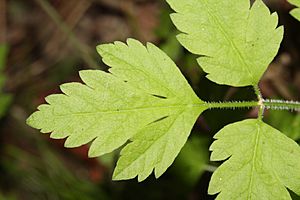Mountain sweet cicely facts for kids
Quick facts for kids Mountain sweet cicely |
|
|---|---|
 |
|
| Scientific classification | |
| Genus: |
Osmorhiza
|
| Species: |
berteroi
|
| Synonyms | |
|
Osmorhiza brevipes |
|
Osmorhiza berteroi, also known as mountain sweet cicely, is a type of flowering plant. It belongs to the Apiaceae family, which also includes carrots and parsley. This plant is known for its pleasant smell.
Contents
About Mountain Sweet Cicely
For a long time, scientists thought Osmorhiza berteroi was the same as another plant called Osmorhiza chilensis. But after more studies, they found out they were actually different species. Now, Osmorhiza berteroi is recognized as its own unique plant.
Scientists use special tools to study the DNA of plants. By looking at the DNA from different parts of the plant, like the chloroplasts, they can understand how different plant groups are related. These studies helped confirm that all the different groups of Osmorhiza berteroi are closely related.
Where It Lives
Mountain sweet cicely grows in both North and South America. This is called an amphitropical distribution. In the Northern Hemisphere, you can find it in cool, northern areas from Alaska to Newfoundland. It also grows south into states like South Dakota. Along the Pacific coast, it lives in mountain ranges from Alaska down to California and Arizona.
In South America, this plant grows in the Magellanic forests of Argentina and Chile. Scientists believe that the seeds of this plant might have traveled between North and South America on the feathers of migratory birds. This journey likely happened in the last million years.
Its Home
This plant likes to grow in areas with lots of trees, like forests and woodlands. In the Great Lakes region, you can often find Osmorhiza berteroi in forests where Sugar Maple trees are common. It prefers places that are a bit shady and moist.
Life Cycle of the Plant
Osmorhiza berteroi is a perennial plant, which means it lives for more than two years. It usually blooms, or flowers, in late spring. For example, in Minnesota, it flowers in June, while in Chile, it flowers from October to December.
Insects help to pollinate its flowers. After the flowers are pollinated, the plant produces seeds. These seeds are spread by animals. They often stick to the fur of mammals, which helps carry them to new places. This way of spreading seeds is called epizoochory.
Plant Friends and Foes
Some animals depend on Osmorhiza berteroi. For example, the tiny young (larvae) of a type of moth called Greya reticulata eat the fruits of this plant. This moth is only found in California.
What It Looks Like
Mountain sweet cicely is an aromatic herb, meaning it has a strong, pleasant smell. It can grow quite tall, sometimes over a meter (about 3 feet). Its stem has many branches.
The plant has lots of green leaves, which can be up to 20 centimeters (about 8 inches) long. Each leaf is divided into three smaller leaflets, which often have jagged edges or lobes. These leaves grow on a long stalk called a petiole.
The flowers are tiny and white. They grow in a cluster at the top of a stem-like stalk, forming a shape called a compound umbel. Each small cluster of flowers has about 4 to 10 tiny flowers. The fruits are long and narrow, with ridges and bristles, and can be up to 2.5 centimeters (about 1 inch) long.
Similar Plants
Osmorhiza berteroi can sometimes be found growing near other plants from the Osmorhiza family. It looks very similar to Osmorhiza depaurerata. The easiest way to tell these two species apart is by looking closely at their seeds.
How People Use It
Food and Medicine
Long ago, several groups of Native Americans used Osmorhiza berteroi as a food source. This included the Selknam people in what is now Chile, and tribes like the Cheyenne and Blackfoot in the Great Plains. They would eat the root of the plant. It was also used as a traditional medicine to help with coughs and colds.
Protecting the Plant
Most of the time, Osmorhiza berteroi is not in danger of disappearing. However, some groups of these plants in eastern North America are separated from others. Their natural homes are sometimes broken up or destroyed by human activities.
In Your Garden
You can also grow mountain sweet cicely in your garden! It makes good groundcover in shady spots. It is a tough plant that can grow well in many different climates, especially in USDA zones 5–9.
Images for kids
See also
 In Spanish: Osmorhiza berteroi para niños
In Spanish: Osmorhiza berteroi para niños


